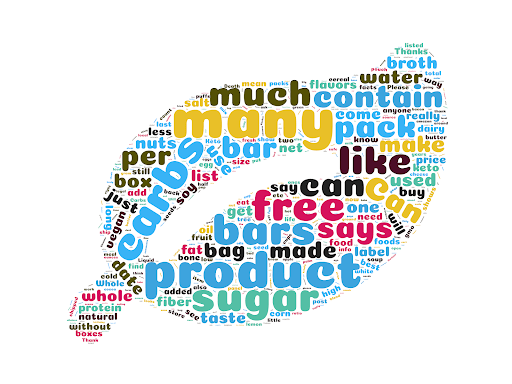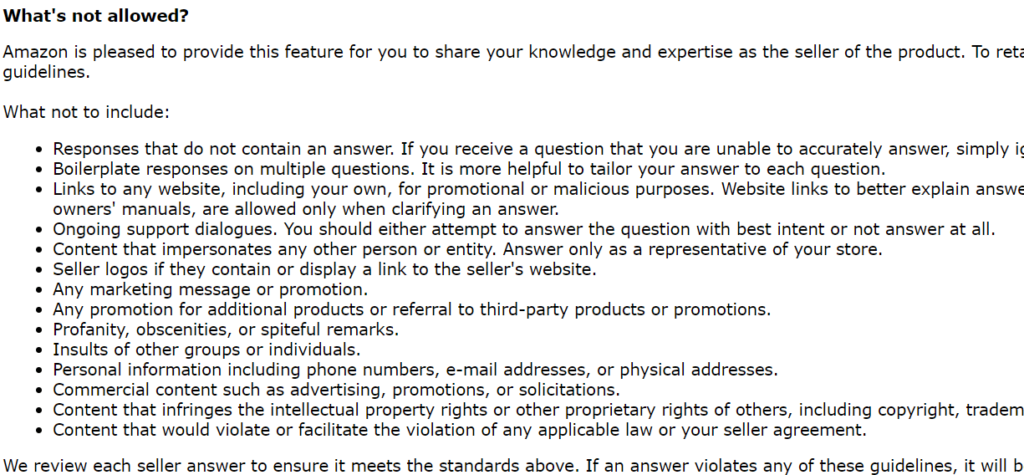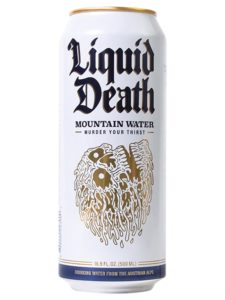What are the top Amazon questions customers are asking?
Are you taking advantage of all of the opportunities to manage your brand messaging online? One place you may have overlooked is Amazon Customer Questions & Answers. On every product page, customers have the opportunity to ask questions which can be upvoted by others. As a seller, you have the opportunity to answer your customers’ questions directly.
Vendor and Seller Central allow you to answer questions with a badge signifying that the responses are coming from a manufacturer or seller. So, what are the most common questions people are asking about food brands on Amazon? And how can you leverage your answers to further your brand message?
We analyzed 626 questions from 71 emerging food products, from protein bars, to keto snacks, gluten-free pastas, yogurts, and more. Here are some of the most frequently asked questions on Amazon today.

Questions about the product’s nutrition

Looking at the word cloud of the question text, you can see words that showed up more frequently are larger. Nutrition words like “sugar,” “carbs,” and “protein” showed up quite frequently. Some other questions we found asked about whether products were non-GMO, GMO-free, or organic. While most questions in this category could be answered by a look at the packaging and nutrition label, customers asked the question anyway. A good example was from Umpqua Oats. Their product page included a preview of the nutrition label and ingredients, and still, one of the most upvoted questions was about information that could be found on the nutrition label.
Questions about taste

Although it’s a very subjective thing to ask, over a dozen questions we analyzed were about what the product tasted like, or were people asking others to compare one product’s taste to another.
This can be a particularly helpful question to answer when the taste may not be so clear. An example of this is Truff Hot Sauce. The hot sauce contains black truffles and agave nectar. Heat isn’t the only feature of the product, so questions about taste can help potential customers understand what they’re getting before they buy it.
Questions about special diets

As you can see, “free” is one of the largest words in the word cloud, and that is because many customers ask questions about whether the products are soy-free, dairy-free, gluten-free, corn-free…you get the picture. While not as prevalent, “keto” also appeared in 13 questions, and “vegan” appeared in 12, three customers asked if products were Whole 30-compliant.
The customer questions & answers section provides customers with the opportunity to figure out whether the food products they’re browsing can work with their special diets. Six questions specifically mentioned the word “allergy” or “allergic,” and a couple asked about cross-contamination with other allergenic ingredients.
Questions about serving size and availability
When we first started analyzing questions customers asked, we expected the questions to be about things customers wouldn’t be able to gather from images on product pages, but surprisingly, most of the questions were not just about ingredients and nutritional values, but also serving sizes, dimensions, and availability.
Questions like, “How many servings are in a box?”, “How many calories are in each serving?”, “How many ounces or servings are in the 5 lb. box?”, and “Not available in any local stores in [my zip code]?” were not as frequent, but still prevalent.
Questions about pricing on Amazon versus in-store

Quite a few customers also had questions about pricing – why the price of the item was different on Amazon than in the store. Most questions about price come from customers complaining that the price was fluctuating on Amazon, or that the price was much more expensive than in stores.
Don’t violate Amazon’s question guidelines
Just because you can answer a question doesn’t always mean you should. According to Amazon, a few topics should be handled in a customer service capacity, not in Customer Q&A: Shipping, availability, customer service, and information pertaining to specific orders will likely get removed eventually by Amazon, so it’s not worth answering them. Those involved in Q&A on either side also need to post in accordance with the Customer Discussion guidelines.
From a seller perspective, Amazon has also outlined some off-limit content in their Seller Answers Guidelines. Answers that don’t contain answers are not allowed, for example. Links to promotional or malicious content, boilerplate responses, impersonating content, and marketing messages are some of the other prohibited response types. Review the guidelines before posting an answer until you get them down, so you don’t accidentally violate a policy. Repeat violations can result in your brand not getting notified of new questions, not to mention wasted time and effort spent crafting answers.

So, how can you use Amazon’s Customer Questions & Answers to your brand’s advantage?
While we often saw vendors and sellers answering questions from customers, this wasn’t always the case. Actually, sometimes other customers’ answers received more upvotes than the seller, leaving their answers buried out of view. Here’s what we suggest if you want to stay on top of the Q&A:
The quicker you respond, the more likely you’ll be able to edge in as the most helpful answer
Pay attention to the notifications you get through Vendor or Seller Central, and answer questions as quickly as you can after they’re asked. That way, your answer will have more time to get upvoted. Keep Amazon’s best practices in mind, and even when answering repetitive questions, try to respond in a way that’s worded differently every time. If your answer feels personal, helpful, and friendly, you’re likely to get upvoted.
Use the Q&A as an opportunity to correct inaccurate information
One of the things we noticed when analyzing questions is that sometimes customers who answer questions provide inaccurate or unhelpful answers. Use the Q&A section as an opportunity to correct anything you see as inaccurate, either from the person asking or answering the question. Think of it as running damage control: Even if you’re not the one putting out incorrect information, a future customer might attribute the answers to your brand, and you might lose their business.
Put your brand voice to work in your answers

Just because you’re answering simple questions doesn’t mean your answers have to be boring. Use the Q&A as your opportunity to extend your brand voice. A brand that stood out, way out, in our research was Liquid Death:
Q: “Does Liquid Death have alcohol in it?”
A: “No. But Liquid Death does contain microscopic chainsaw maniacs that will savagely dismember the thirst neurons in your brain.”
Q: “Is Liquid Death vegan and cruelty free?”
A: “Liquid Death is 100% vegan and cruelty-free. And we never keep our cans in cages.”
Not only are these answers entertaining, they resulted in way more upvotes than any other questions we had seen. 102 on the most popular one, 82 on the second one, and so on. Whether you decide to be chipper, sarcastic, or add in a pun or two, adding some elements of your brand personality into your answers can liven up an otherwise dull exchange.
Summary
- The top Amazon questions people are asking of emerging food brands are simpler than you might think. Most are about nutrition information, ingredients, serving sizes, availability, and taste
- While you are encouraged to have unique answers for all questions customers ask on Amazon, there are a few things you shouldn’t do, like drive visitors to promotional off-site content or address customer service concerns.
- Just because you’re answering basic questions doesn’t mean your responses have to be dry. Infuse answers with your brand voice to liven things up


